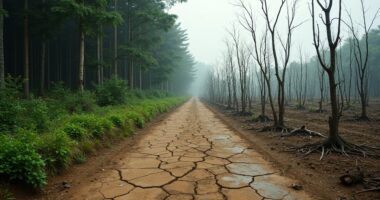The Chyulu Hills REDD+ Project, a key conservation effort in Kenya, is facing significant backlash regarding its reliance on carbon offsets, especially with Apple involved. Critics argue that this model might foster financial dependence instead of sustainable growth, raising eyebrows about transparency and revenue allocation. It’s like relying on a sugar rush for energy—exciting but ultimately unsustainable. As the project juggles environmental victories and scrutiny, the conversation around its future becomes increasingly relevant. What comes next?
Challenges Facing the Chyulu Hills REDD+ Project
What happens when a groundbreaking conservation project designed to save forests and uplift communities suddenly finds itself in hot water?
The Chyulu Hills REDD+ Project, a massive initiative stretching over 410,000 hectares of threatened forestland in Kenya, is facing scrutiny.
Launched in 2011, this ambitious project aims to tackle deforestation while promoting climate, community development, and biodiversity.
But now, its innovative approach, which empowers local communities to decide how to use carbon credit revenues, is under fire.
The project’s community-driven approach to carbon credit revenues faces increasing scrutiny and challenges.
Imagine a neighborhood potluck where everyone gets a say in the dishes.
That’s the essence of the Chyulu Hills project.
With a governance structure led by organizations like Conservation International and the Maasai Wilderness Conservation Trust, stakeholders are united in a collaborative effort.
Communities take charge of their own priorities, but this newfound power has led to questions about revenue allocation and transparency.
The project isn’t just about saving trees; it’s also about creating jobs and enhancing local education. Annual carbon credits are generated as part of the project’s efforts, contributing to both economic and environmental goals.
Ranger employment and conservation-related positions have bolstered the community, while initiatives targeting women’s empowerment have added another layer of social benefit.
However, critics argue that the carbon credit model, which offers an alternative funding source beyond traditional eco-tourism, might create dependency rather than sustainable growth.
The environmental protection efforts are impressive: over 641 poaching traps removed and more than 11,000 tree seedlings planted. Additionally, this region is known for being home to Kenya’s largest surviving elephant population, which underscores the project’s ecological significance.
But some wonder if these victories can withstand the pressure of financial scrutiny.
With fire control measures and anti-poaching efforts in place, the project seems to hold promise, yet the criticism presents a cautionary tale.
In a world where climate change is the hot topic at every dinner table, the Chyulu Hills REDD+ Project stands as a beacon of hope.
But like any good story, it faces its share of twists and turns, reminding us that even the noblest of endeavors can encounter bumps along the way.








